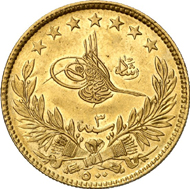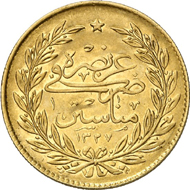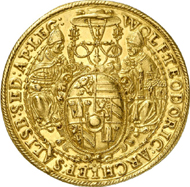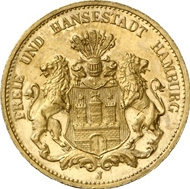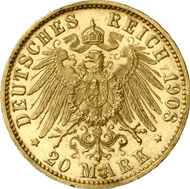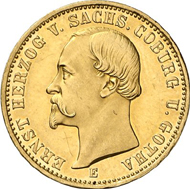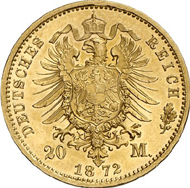[bsa_pro_ad_space id=4]
12-12-2011 – 13-12-2011
Auction 199-200
130,000 Euro for the rarest coin of the German Empire
1024x768 Normal 0 21
It was on page 75 where the rarest type of all German Empire gold coins beamed at the viewer, with 3x magnification: 20 Mark 1872 of Duke Ernest II of Saxe-Coburg and Gotha. Catalog number 1496, about brilliant uncirculated, was estimated at 75,000 Euros. However, biddings started with 80,000 Euros already. They rose up to more than 100,000 Euros, to finally arrive at 130,000 Euros. That was a new record price for this very rare gold coin on December 14. Did you read December? Yes, auction house Künker had come up with a fifth date, additional to the usual four sale dates, a Christmas auction all shining with gold. It involved the one and only complete collection of gold coins of the German Empire worldwide, that, as was to be expected, attracted many interested parties to Steigenberger Hotel Remarque. Künker, having celebrated its 40th anniversary only recently, closed the jubilee year with two catalogs, roughly 1800 numbers and a total hammer price of 2.7 million Euros. The total estimate of approximately 1.8 million Euros was exceeded by roughly 45 per cent. As associates, the companies Numisart Roland Michel and Mages GmbH participated in the two-day auction.
1024x768 Normal 0 21
However, it paid off to arrive early, on December 13, when catalog 199, “Coins of the Ottoman Empire” was scheduled. With the addition “Part I”, for there are parts II and III to be auctioned off in summer and autumn 2012. The first part contained 900 numbers with a total estimate of approximately 430,000 Euros, which was exceeded by roughly 50 per cent. On closer inspection, the coins of the Ottomans with the elaborate depiction of the tughra are very interesting, and the Künker auction catalog, with its magnificent professional descriptions and the beautiful illustrations, is once again a sought-after work of reference. Writing this catalog was the thing to do: there is only one so comprehensive an Ottoman collection in the world.
763: Ottoman Empire. Muhammad V, 1909-1918. 500 Kurush 1327 H. on the city visit to Manastir. KM 807. Only 20 specimens were minted. Extremely fine. Estimate: 7,500 EUR. Hammer price: 36,000 EUR.
1024x768 Normal 0 21
The hammer prices of the Ottomans, offered in the best qualities, ranged from 35 Euros for 5 Kurush1327 H. (two specimens) and 36,000 Euros for 500 Kurush from the same year. Muhammad V (1327-1336 H. / A.D. 1909-1918) had had produced only 20 specimens of this denomination. Both these results testify as to how unpredictable auctions might be: the estimate of the lot was 40 Euros, for the later biggest hammer price of the Ottoman collection “just” 7,500 Euros. The Kurush proves how much intertwined the numismatic regions are: Kurush and Ghurush derive from grossus, grosso and Groschen.
1024x768 Normal 0 21
The offer of catalog 200 divided into several parts, the Vogel Collection (Hamburg, Part I) with “German Gold Coins” and “A Complete Collection of German Empire Gold Coins” as well as “Paper Money”.
1006: Salzburg. Wolf Dietrich of Raitenau, 1587-1612. 10 Ducats 1594, Turmprägung. Fb. 672. Extremely fine. From Vogel Collection. Estimate: 25,000 EUR. Hammer price: 44,000 EUR.
1024x768 Normal 0 21
A bestseller came from Salzburg: the 10 Ducat piece of Wolf Dietrich of Raitenau, estimated at 25,000 Euros, yielded 44,000 Euros – rare, very attractive, extremely fine, an extraordinary specimen. Further estimates were outbid, like the one for a gold pattern of six Ducats of the dies of the 2/3 Taler from Saxony: instead of 15,000 Euros, it became 32,000. Another case in point is the 5 Ducat 1733 from Dresden which more than doubled its estimate of 10,000 Euros with its price of 24,000 Euros, or the 5 Ducat 1685 of Maximilian II Emanuel of Bavaria, for which 22,000 Euros had to be paid, instead of its estimate of 12,500. These are only a few examples from this collection’s shining range of offers. Neither with the Gold (149 numbers) nor with the following German Empire Gold (420 numbers) were there any lots left unsold. The total estimates were beaten by 60 and 30 per cent, respectively.
1284: Hamburg. 20 Mark 1908. J. 212. About brilliant uncirculated. Single specimen on the market. Rarest gold coin of the German Empire. Estimate: 125,000 EUR. Hammer price: 110.000 EUR.
1024x768 Normal 0 21
The selection of German Empire Gold contained more than one accent. The Hamburg gold coin of 20 Mark 1881 were available only for 36,000 Euros in the end (estimate: 20,000 Euros), and the same Hamburg denomination, the only one on the market, with the year 1908 brought 110,000 Euros (estimate: 125,000 Euros). The 10 Mark piece of Friedrich Franz II of Mecklenburg from 1872 yielded 19,000 Euros (10,000 Euros) …
1368: William I. 10 Mark 1878 B. Of greatest rarity. Very fine. Estimate: 60,000 EUR. Hammer price: 80,000 EUR.
1024x768 Normal 0 21
… the very denomination but six years later, of William I of Prussia, 80,000 Euros (estimate: 60,000).
1496: Ernst II, 1844-1893. 20 Mark 1872. Splendid specimen. Rarest type of all coins of the German Empire. Estimate: 75,000 EUR. Hammer price: 130,000 EUR.
1024x768 Normal 0 21
Heinrich XXII, Prince Reuss of Greiz, has left one gold coin only, 20 Mark 1875, estimated at 35,000 Euros, sold for 46,000 Euros. The estimates of 20,000 Euros each for the two coins from New Guinea from 1895 weren’t enough for them: the hammer went down at 28,000 Euros for the first one, at 30,000 Euros for the double denomination.
1024x768 Normal 0 21
Anyone suspecting that paper money would become something of a lifeless event, after this brilliant presentation of Künker’s gold offer, was disabused at the end of the two-day Christmas auction. 400 individual numbers and lots, estimated at approximately 100,000 Euros altogether, realized almost 220,000 Euros – that truly was some increase. The range covered 40 Euros (estimate: 50 Euros) for the oldest Mexican bank note from 1823 to 11,000 and 12,000 Euro (estimate: 500 Euros each) for two Czech notes of 500 Korun 1923. Several series stood out, such as the collecting fields of Danzig, Estonia of Belgium. Hence, it were golden days for the collector of paper money, too. Or, to put it in other words: it was a nice how-d’ye-do shortly before Christmas in Osnabrück.
1024x768 Normal 0 21
The results of the auction can be viewed on the internet, to order the fantastic auction catalogs please click here.




